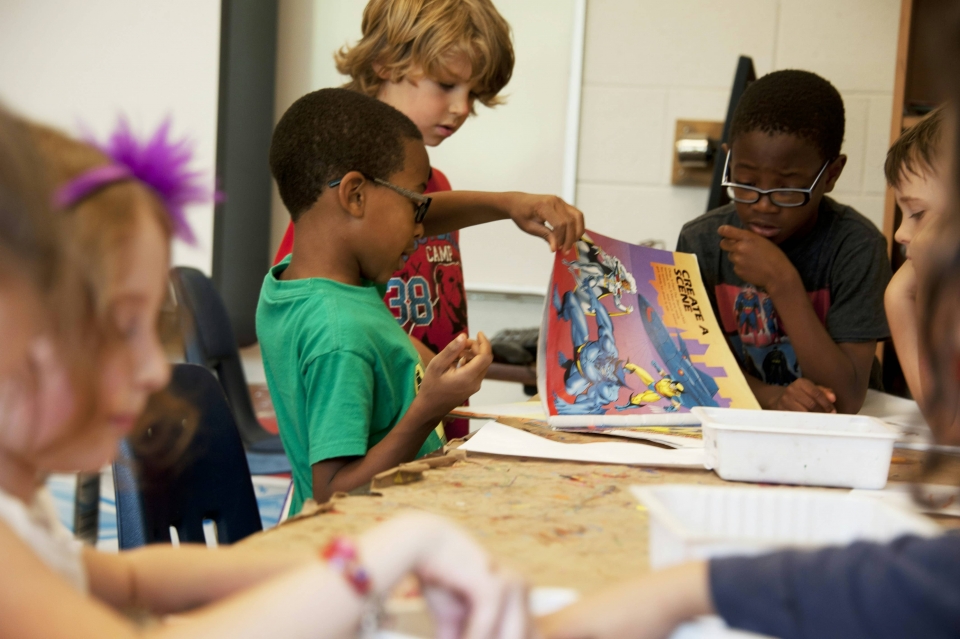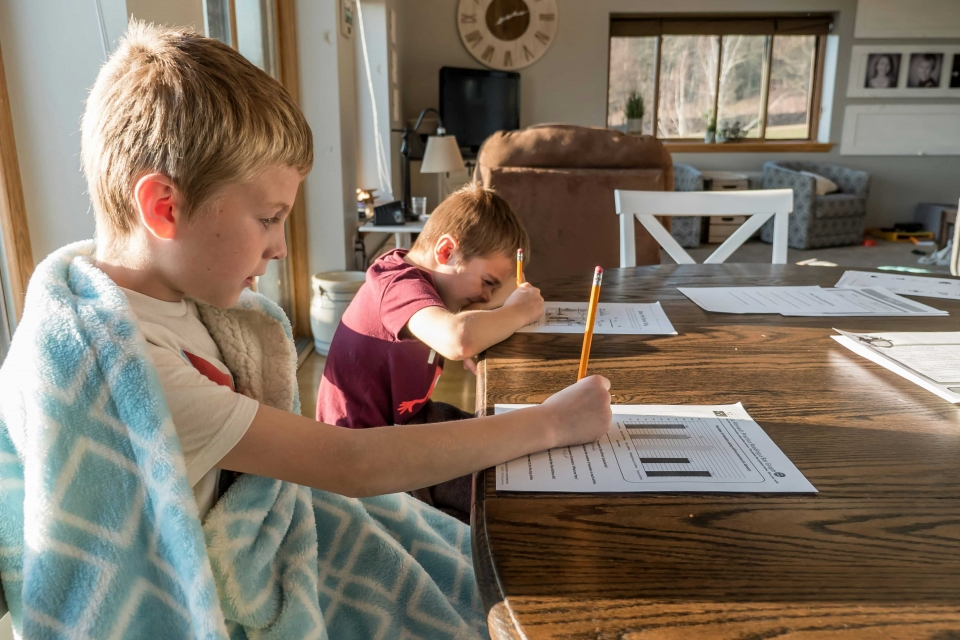Blog
The Best Ways for Children to Learn at Home
Added 30th July 2024
The Best Ways for Children to Learn at School and at Home
In our rapidly evolving world, understanding how children learn is crucial. With both school and home playing pivotal roles in education, blending the best practices from both environments can create an enriching learning experience for children. Whether you're a parent, teacher, or guardian, this guide will help you discover the most effective ways to support children's learning journeys.
Understanding Child Development and Learning
Understanding how children develop cognitively, socially, and emotionally lays the groundwork for tailoring educational approaches that resonate with their individual learning styles.
Key Stages of Child Development
Child development is a complex process that unfolds through various stages. From birth to adolescence, children go through significant physical, cognitive, and emotional changes. Recognising these stages helps tailor learning experiences to meet their developmental needs.
Theories of Learning (Piaget, Vygotsky, etc.)
Several influential theories offer insights into how children learn. Jean Piaget's theory of cognitive development suggests that children move through four distinct stages, each characterised by different learning abilities. Lev Vygotsky's social development theory emphasises the importance of social interaction and cultural tools in learning. These theories, among others, provide a foundation for understanding and supporting children's educational growth.
Learning Styles in Children
Recognising the unique learning styles of children is essential for fostering an effective educational environment that caters to their individual preferences and strengths.
Visual, Auditory, and Kinaesthetic Learning Styles
Children have diverse ways of processing information, known as learning styles. Visual learners thrive on images and spatial understanding, auditory learners benefit from listening and verbal instructions, and kinaesthetic learners excel through hands-on activities. Identifying your child's preferred learning style can enhance their educational experience.
How to Identify Your Child's Preferred Learning Style
Observing how your child engages with different activities can reveal their learning style. Do they prefer reading books with lots of pictures or listening to stories? Do they enjoy building models or performing experiments? Understanding these preferences can guide you in selecting appropriate learning methods and materials.
Best Practices for Learning at School
When it comes to optimising a child's learning experience, implementing best practices in the classroom is essential.
Interactive Learning
Interactive learning involves engaging students in hands-on activities and experiments. This approach encourages active participation and fosters a deeper understanding of concepts. For example, a teamwork project on aviation can teach children about aerodynamics, problem-solving, and collaboration.
Collaborative Learning
Collaborative learning allows students to work together on group projects and peer learning activities. This method promotes communication, critical thinking, and teamwork skills. It also provides opportunities for students to learn from each other and gain diverse perspectives.
Technology in Education
The integration of technology in education has revolutionised the learning process. Educational apps, interactive whiteboards, and online resources make learning more engaging and accessible. Tools like Kahoot! and Google Classroom offer interactive platforms for quizzes, discussions, and assignments, enhancing the overall educational experience.
Effective Teaching Methods
Effective teaching methods are essential for creating an enriching learning environment that caters to the diverse needs of students.
Differentiated Instruction
Differentiated instruction tailors teaching methods to meet the diverse needs of students. By recognising individual learning styles, interests, and abilities, teachers can create customised lesson plans that maximise student engagement and understanding.
Scaffolding
Scaffolding involves providing temporary support to students as they learn new concepts. This support is gradually removed as students gain confidence and competence. Techniques like questioning, modelling, and feedback help students build their understanding and skills progressively.
Formative Assessment
Formative assessment is a continuous process of evaluating student progress. It includes activities like quizzes, observations, and feedback sessions. This approach allows teachers to identify areas where students need additional support and adjust their teaching strategies accordingly.
Creating a Conducive Learning Environment at School

Creating a conducive learning environment at school is essential for fostering student engagement, motivation, and a sense of belonging.
Importance of Classroom Setup and Resources
A well-organised classroom with adequate resources is essential for effective learning. Comfortable seating, sufficient lighting, and accessible learning materials create an inviting and productive environment.
Enhance the visual appeal with interactive displays, educational posters, and classroom decoration ideas like colorful bulletin boards, themed decor, or plant arrangements to inspire creativity and engagement among students.
Role of Teachers in Fostering a Positive Learning Environment
Teachers play a vital role in creating a positive learning atmosphere. Establishing clear expectations, promoting mutual respect, and encouraging open communication foster a supportive and inclusive classroom culture. Recognising and celebrating student achievements also boosts motivation and self-esteem.
Best Practices for Learning at Home
Creating a supportive learning environment at home is equally important for reinforcing the skills and concepts learned in school.
Establishing a Routine
Consistency is key to effective learning at home. Establishing a regular study schedule helps children develop discipline and time management skills. A consistent routine also ensures that children allocate sufficient time for both academic and leisure activities.
Creating a Learning Space
A dedicated, distraction-free area for study enhances focus and productivity. Ensure that the learning space is comfortable, well-lit, and equipped with necessary supplies like stationery and textbooks. This designated area signals to children that it's time to concentrate on their studies.
Parental Involvement
Active parental involvement significantly impacts a child's learning experience. Parents can support their child's education by helping with homework, discussing school activities, and encouraging a love for learning. Regular communication with teachers also keeps parents informed about their child's progress and areas that may need attention.
Effective Learning Activities at Home
Effective learning activities at home can stimulate a child's curiosity and enhance their understanding of various subjects.
Educational Games and Activities
Incorporating learning into play makes education enjoyable and engaging. Educational games and activities, like puzzles, board games, and DIY science experiments, stimulate curiosity and creativity. For instance, a simple kitchen science experiment can make children learn while having fun.
Reading Together
Reading together fosters a love for literature and enhances language skills. Encourage children to read a variety of books and discuss the stories with them. This practice improves comprehension, vocabulary, and critical thinking abilities.
Practical Life Skills
Teaching children practical life skills through everyday tasks and chores instills responsibility and independence. Activities like cooking, gardening, and budgeting provide hands-on learning experiences that are valuable for their holistic development.
Balancing School and Home Learning
Balancing school and home learning is crucial for nurturing a child's development and ensuring they thrive academically and personally.
Strategies for Ensuring Consistency Between School and Home Education
Consistency between school and home education is crucial for reinforcing learning. Maintaining open communication with teachers ensures that parents are aware of the curriculum and can support their child's learning at home. Coordinating schedules and activities also helps create a seamless learning experience.
Communication Between Teachers and Parents
Effective communication between teachers and parents is essential for addressing any learning challenges and celebrating successes. Regular meetings, emails, and progress reports keep parents informed and involved in their child's education. This collaboration ensures that students receive the necessary support both at school and at home.
Overcoming Learning Challenges
Overcoming learning challenges requires a proactive approach that involves identifying obstacles and implementing effective strategies to support students.
Identifying and Addressing Learning Difficulties
Early identification of learning difficulties allows for timely intervention and support. Parents and teachers should look for signs of struggle, such as difficulty following instructions or retaining information. Seeking professional assessments and resources, like tutoring or specialised programs, can help address these challenges effectively.
Seeking Additional Support and Resources
There are numerous resources available to support children with learning difficulties. Educational websites, online tutorials, and community programs offer valuable assistance. Collaborating with specialists, such as speech therapists or educational psychologists, provides targeted support tailored to the child's needs.
Using Technology to Enhance Learning

In today's digital age, technology plays a pivotal role in enhancing the learning experience for children both at home and in school.
Benefits and Drawbacks of Digital Learning Tools
Digital learning tools offer numerous benefits, such as interactive content, personalised learning experiences, and access to a vast array of resources. However, it's important to balance screen time with offline activities and ensure that digital tools are used responsibly. Supervision and guidance from parents and teachers are crucial in maximising the benefits of technology.
Recommended Educational Apps and Websites
Several educational apps and websites cater to different subjects and age groups. Apps like Khan Academy, Duolingo, and Scratch provide engaging platforms for learning math, languages, and coding. Websites like National Geographic Kids and Science Fun offer informative and entertaining content that sparks curiosity and exploration.
Incorporating Extracurricular Activities
Extracurricular activities are vital for the holistic development of children, offering opportunities for skill enhancement beyond the classroom.
Importance of Sports, Arts, and Hobbies in Holistic Development
Extracurricular activities play a vital role in a child's overall development. Sports, arts, and hobbies provide opportunities for physical exercise, creativity, and social interaction. These activities help children develop essential life skills, such as teamwork, discipline, and time management.
How Extracurricular Activities Complement Academic Learning
Extracurricular activities complement academic learning by fostering skills that are valuable in the classroom. Participation in sports enhances physical fitness and concentration, while artistic pursuits encourage creativity and problem-solving. Engaging in hobbies and clubs also broadens a child's interests and passions.
Fostering a Lifelong Love of Learning
Creating a nurturing environment that values and supports education, both at school and at home, sets the foundation for a lifelong love of learning. By understanding how children learn and implementing effective strategies, parents and teachers can inspire curiosity, creativity, and a passion for knowledge.
Remember, every child is unique, and their learning journeys are individual. By tailoring approaches to meet their needs and interests, we can empower them to reach their full potential.
Blog Tags
- 'My Future Clubs' (3)
- Aviation (35)
- Bristol Loves Tides (21)
- Build My Future (20)
- Carboard Boat Race (1)
- Cards (8)
- careers (2)
- catch the train to my future (2)
- Citizenship (21)
- Classroom Afloat (9)
- Coaching (2)
- community (16)
- competition (16)
- Constructing and creating (98)
- consultancy (1)
- CPD (14)
- Crossing Coasts - Windrush Project (3)
- Design My School (1)
- Design solutions (12)
- DIY Energy (4)
- Documentary film making (1)
- Early Years (3)
- Engineering (100)
- Engineers (25)
- Engineers Top Trumps Pack (8)
- Entrepenuer (1)
- Exhbitions on Balmoral (2)
- Family (26)
- female engineers (29)
- Festivals (1)
- Financial Education (1)
- Goal Setting (4)
- Higher Education (9)
- Home Learning (2)
- IMechE (4)
- Ingenious (8)
- Institute of Structural Engineers (1)
- Learning Ships (31)
- Learning Ships (3)
- learning Ships (1)
- Lifting Aspirations - Accessing Engineering (20)
- Literacy (1)
- Museum (15)
- outdoors learning (14)
- parents (5)
- PHSE (17)
- Plan My Future (1)
- Power and thrust (12)
- Primary (24)
- Primary (12)
- Primary School (35)
- Reach Out My Experience (2)
- Resources (11)
- Resources - Card Game, Posters, Workbooks etc (7)
- Rocking the Boat (1)
- Science Festival (5)
- Science learning (18)
- Secondary (26)
- Secondary school (52)
- Self Belief (10)
- self evaluation (7)
- Shipping 2050 (2)
- survey (1)
- Sustainability (1)
- transition (13)
- UTC (2)
- Visioning (26)
- Volunteering (35)
- Windrush (2)
- Work Experience (23)
- Workshops (32)
- Wroughting (1)
- 'My Future Clubs' (3)
- Aviation (35)
- Bristol Loves Tides (21)
- Build My Future (20)
- Carboard Boat Race (1)
- Cards (8)
- careers (2)
- catch the train to my future (2)
- Citizenship (21)
- Classroom Afloat (9)
- Coaching (2)
- community (16)
- competition (16)
- Constructing and creating (98)
- consultancy (1)
- CPD (14)
- Crossing Coasts - Windrush Project (3)
- Design My School (1)
- Design solutions (12)
- DIY Energy (4)
- Documentary film making (1)
- Early Years (3)
- Engineering (100)
- Engineers (25)
- Engineers Top Trumps Pack (8)
- Entrepenuer (1)
- Exhbitions on Balmoral (2)
- Family (26)
- female engineers (29)
- Festivals (1)
- Financial Education (1)
- Goal Setting (4)
- Higher Education (9)
- Home Learning (2)
- IMechE (4)
- Ingenious (8)
- Institute of Structural Engineers (1)
- Learning Ships (31)
- Learning Ships (3)
- learning Ships (1)
- Lifting Aspirations - Accessing Engineering (20)
- Literacy (1)
- Museum (15)
- outdoors learning (14)
- parents (5)
- PHSE (17)
- Plan My Future (1)
- Power and thrust (12)
- Primary (24)
- Primary (12)
- Primary School (35)
- Reach Out My Experience (2)
- Resources (11)
- Resources - Card Game, Posters, Workbooks etc (7)
- Rocking the Boat (1)
- Science Festival (5)
- Science learning (18)
- Secondary (26)
- Secondary school (52)
- Self Belief (10)
- self evaluation (7)
- Shipping 2050 (2)
- survey (1)
- Sustainability (1)
- transition (13)
- UTC (2)
- Visioning (26)
- Volunteering (35)
- Windrush (2)
- Work Experience (23)
- Workshops (32)
- Wroughting (1)
Blog Archives
- September 2025 (2)
- August 2025 (1)
- July 2025 (4)
- April 2025 (3)
- November 2024 (3)
- October 2024 (3)
- September 2024 (3)
- August 2024 (2)
- July 2024 (2)
- May 2024 (2)
- January 2024 (1)
- December 2023 (4)
- October 2023 (2)
- August 2023 (2)
- July 2023 (2)
- June 2023 (1)
- May 2023 (1)
- April 2023 (1)
- March 2023 (2)
- February 2023 (1)
- January 2023 (1)
- November 2022 (1)
- September 2022 (2)
- August 2022 (1)
- July 2022 (4)
- April 2022 (1)
- March 2022 (1)
- December 2021 (1)
- October 2021 (2)
- September 2021 (5)
- July 2021 (2)
- June 2021 (1)
- May 2021 (3)
- April 2021 (1)
- March 2021 (2)
- February 2021 (2)
- December 2020 (2)
- November 2020 (1)
- October 2020 (5)
- August 2020 (1)
- July 2020 (1)
- June 2020 (1)
- May 2020 (2)
- April 2020 (2)
- January 2020 (1)
- December 2019 (2)
- November 2019 (2)
- September 2019 (2)
- August 2019 (2)
- July 2019 (3)
- June 2019 (5)
- May 2019 (4)
- April 2019 (2)
- March 2019 (1)
- December 2018 (1)
- November 2018 (2)
- October 2018 (7)
- September 2018 (2)
- August 2018 (1)
- July 2018 (5)
- June 2018 (2)
- May 2018 (3)
- April 2018 (1)
- March 2018 (5)
- February 2018 (3)
- November 2017 (2)
- October 2017 (1)
- August 2017 (1)
- July 2017 (6)
- May 2017 (2)
- April 2017 (2)
- March 2017 (2)
- February 2017 (1)
- January 2017 (2)
- December 2016 (3)
- November 2016 (6)
- August 2016 (3)
- July 2016 (4)
- June 2016 (1)
- May 2016 (1)
- March 2016 (3)
- February 2016 (1)
- December 2015 (2)
- November 2015 (3)
- October 2015 (1)
- September 2015 (1)
- August 2015 (1)
- July 2015 (5)
- May 2015 (3)
- April 2015 (2)
- March 2015 (3)
- February 2015 (1)
- January 2015 (2)
- December 2014 (2)
- November 2014 (6)
- October 2014 (1)
- September 2014 (3)
- August 2014 (1)
- July 2014 (3)
- June 2014 (1)
- May 2014 (2)
- April 2014 (1)
- March 2014 (3)
- February 2014 (2)
- January 2014 (3)
- December 2013 (6)
- November 2013 (4)
- October 2013 (3)
- September 2013 (1)
- August 2013 (4)
- July 2013 (4)
- June 2013 (2)
- May 2013 (1)
- April 2013 (1)
- March 2013 (2)
- January 2013 (1)
- December 2012 (2)
- October 2012 (3)
- September 2012 (2)
- August 2012 (1)
- July 2012 (6)
- May 2012 (3)
- April 2012 (2)
- March 2012 (1)
- February 2012 (4)
- January 2012 (4)
- November 2011 (2)
- October 2011 (2)
- September 2011 (7)
- August 2011 (2)
- November -0001 (1)
